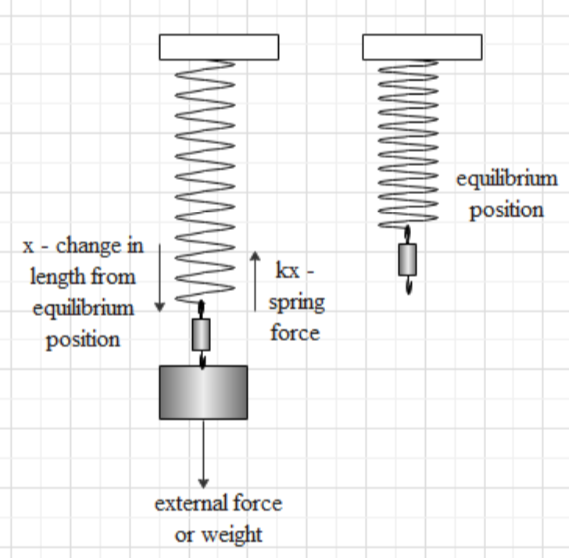
The working principle of the spring balance is
A). Newton’s laws of motion
B). Hooke's law
C). Ohm’s law
D). None of the above
Answer
582.6k+ views
Hint: Imagine a spring is expanding or compressing due to the presence of external force. We will feel an opposition to obtain the equilibrium state of the spring. This opposing force is exactly equal to the external force on the spring. Using this concept, we measure with the help of spring balance.
Complete step-by-step answer:
The spring can either be extended or compressed by applying an external force on it. When we apply an external force on spring it will produce an opposite balancing force to keep the spring in stable condition. For the same distance of extension and compression, the balancing force produced by the spring will be the same.

Suppose to extend the spring at X distance and external force applied is ${{\text{F}}_{\text{ext}}}$. The spring will produce an opposite balancing force to keep the spring stable is ${{\text{F}}_{\text{bal}}}$.
${{F}_{bal}}\propto X$
${{F}_{bal}}=kX$
A balanced condition
${{\text{F}}_{\text{ext}}}\text{=}{{\text{F}}_{\text{bal}}}$
${{F}_{ext}}=k{{X}^{{}}}$ ………..(i)
Where, $k=$ proportionality constant called the spring constant.
The last equation is called the hooke's equation. For various, the distance applied force should be varied too.
Note: In this question, students will be confused between two option (A) newton’s laws of motion and option (B) hooke's laws. Because spring is part of the mechanics of physics and in the mechanics part mainly newton’s laws of motion are used. But, if you remember the equation of the spring balance you can eliminate the option(A).
The option(C) ohm’s laws, we know that this law is part of electrical physics so we will eliminate this because our question is from mechanics physics.
Complete step-by-step answer:
The spring can either be extended or compressed by applying an external force on it. When we apply an external force on spring it will produce an opposite balancing force to keep the spring in stable condition. For the same distance of extension and compression, the balancing force produced by the spring will be the same.

Suppose to extend the spring at X distance and external force applied is ${{\text{F}}_{\text{ext}}}$. The spring will produce an opposite balancing force to keep the spring stable is ${{\text{F}}_{\text{bal}}}$.
${{F}_{bal}}\propto X$
${{F}_{bal}}=kX$
A balanced condition
${{\text{F}}_{\text{ext}}}\text{=}{{\text{F}}_{\text{bal}}}$
${{F}_{ext}}=k{{X}^{{}}}$ ………..(i)
Where, $k=$ proportionality constant called the spring constant.
The last equation is called the hooke's equation. For various, the distance applied force should be varied too.
Note: In this question, students will be confused between two option (A) newton’s laws of motion and option (B) hooke's laws. Because spring is part of the mechanics of physics and in the mechanics part mainly newton’s laws of motion are used. But, if you remember the equation of the spring balance you can eliminate the option(A).
The option(C) ohm’s laws, we know that this law is part of electrical physics so we will eliminate this because our question is from mechanics physics.
Recently Updated Pages
Why are manures considered better than fertilizers class 11 biology CBSE

Find the coordinates of the midpoint of the line segment class 11 maths CBSE

Distinguish between static friction limiting friction class 11 physics CBSE

The Chairman of the constituent Assembly was A Jawaharlal class 11 social science CBSE

The first National Commission on Labour NCL submitted class 11 social science CBSE

Number of all subshell of n + l 7 is A 4 B 5 C 6 D class 11 chemistry CBSE

Trending doubts
What is meant by exothermic and endothermic reactions class 11 chemistry CBSE

10 examples of friction in our daily life

One Metric ton is equal to kg A 10000 B 1000 C 100 class 11 physics CBSE

1 Quintal is equal to a 110 kg b 10 kg c 100kg d 1000 class 11 physics CBSE

Difference Between Prokaryotic Cells and Eukaryotic Cells

What are Quantum numbers Explain the quantum number class 11 chemistry CBSE




